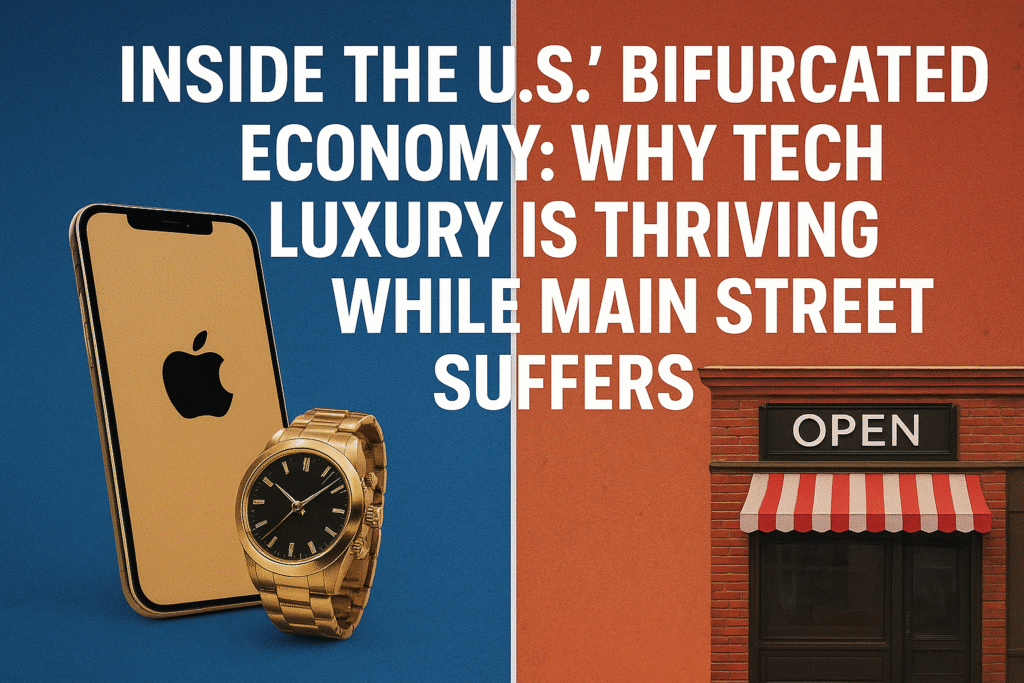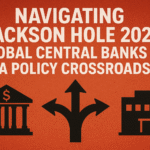Is the U.S. really in a recession or a boom? Explore the deep forces behind America’s bifurcated economy, where Big Tech and luxury goods soar while Main Street businesses and average households struggle with inflation and economic pressure.
Introduction: Two Economies, One Nation
Walk down the streets of any major American city, and you witness a paradox. On one corner, a once-bustling family-owned restaurant closes its doors, a victim of rising food costs and dwindling customer spending. A block away, a Tesla showroom displays its latest electric model, and an Apple Store is packed with customers purchasing $1,000+ smartphones.
This isn’t just anecdotal; it’s the stark reality of the U.S. bifurcated economy. This term describes a profound economic split where two distinct sectors—technology-driven “haves” and traditional “have-nots”—are moving in opposite directions at an accelerating pace. While stock markets hit record highs and tech giants report staggering profits, a significant portion of the population feels squeezed by inflation, stagnant wages, and economic uncertainty.
This article delves deep into the mechanisms of this great divergence. We will explore the powerful forces—technological disruption, monetary policy, and long-term societal shifts—that have created this divide. We’ll examine the data, hear the human stories, and analyze what this means for the future of American capitalism.
Defining the Divide – What is a Bifurcated Economy?
A bifurcated economy is not a formal economic term but an accurate descriptor for a system where economic performance, consumer behavior, and business health are sharply divided along sectoral, corporate, and demographic lines.
Think of it not as a single tide lifting all boats, but as a powerful current lifting luxury yachts while smaller vessels are left battling the waves. The key characteristics include:
- The Corporate Split: “Superstar” firms, predominantly in tech and finance, achieve massive scale and profitability, while small and medium-sized enterprises (SMEs) on Main Street face intense margin pressure.
- The Market Split: The S&P 500, heavily weighted towards a handful of tech giants (Apple, Microsoft, Nvidia, Amazon, Meta), soars while broader market indices and small-cap indexes lag significantly.
- The Consumer Split: High-earning professionals, buoyed by stock-based compensation and remote work flexibility, continue to spend robustly on travel, luxury goods, and technology. Lower and middle-income households, whose budgets are dominated by essentials like food, housing, and energy, are forced to pull back, practicing what economists call “selective frugality.”
This division creates a distorted national picture. Aggregate economic data like GDP might look healthy, but it masks the underlying fragility and inequality that defines the lived experience for millions.
The Engine of Division – Forces Fueling the Split
The bifurcation isn’t an accident; it’s the result of a confluence of powerful, self-reinforcing trends.
1. The Winner-Take-All Digital Economy
The rise of platform-based businesses has created unprecedented economies of scale. A company like Google or Amazon can add millions of new users with minimal marginal cost. This digital scalability allows them to dominate markets, accumulate vast cash reserves, and invest in future-proofing technologies like AI. A local retailer or service business has no such advantage; its growth is constrained by physical location and linear costs.
2. The AI and Automation Acceleration
The rapid adoption of Artificial Intelligence is a key accelerant of bifurcation in 2024. Tech companies are the primary creators and beneficiaries of AI. They see massive productivity gains and new revenue streams. For many white-collar professions in law, finance, and marketing, AI is a powerful tool. However, for roles based on routine tasks, whether in data entry or manufacturing, AI represents a threat of obsolescence, further polarizing the labor market.
3. The Lingering Effects of Pandemic-Era Policy
The massive fiscal and monetary stimulus deployed during COVID-19 was necessary but had uneven effects. It inflated asset prices (homes, stocks), disproportionately benefiting the wealthier segments of the population who own them. Meanwhile, the stimulus-fueled demand surge, combined with supply chain shocks, ignited the inflation that now erodes the purchasing power of wage earners.
4. The High-Interest Rate Environment
The Federal Reserve’s primary tool to fight inflation is raising interest rates. This creates a cruel irony:
- For Big Tech: Large, cash-rich companies are less reliant on debt. They can easily service existing loans and even earn more on their cash reserves thanks to higher interest rates. Their strong balance sheets make them a “safe haven” for investors.
- For Main Street: Small businesses often rely on credit lines and loans for inventory, payroll, and expansion. Higher borrowing costs directly cut into their profits, stifle growth, and can be the difference between survival and failure. Similarly, higher mortgage rates have crushed affordability for first-time homebuyers, cementing a divide between asset owners and renters.
The Thriving Side – An Inside Look at the “Tech Luxury” Boom
This side of the bifurcation is characterized by robust health, innovation, and seemingly limitless spending.
The “Magnificent Seven” and Market Dominance:
A small group of tech stocks—Apple, Microsoft, Alphabet (Google), Amazon, Nvidia, Meta, and Tesla—now wield outsized influence over the entire market. Their combined market capitalization often dwarfs entire sectors. Their earnings reports consistently beat expectations, driven by:
- Cloud Computing: A high-margin, essential service for businesses worldwide.
- Digital Advertising: An oligopolistic market controlled by Google and Meta.
- AI Hardware and Software: Nvidia’s chips are the literal gold rush picks and shovels of the AI revolution.
- Subscription Models: Recurring revenue from services like Microsoft 365, Amazon Prime, and Apple’s ecosystem provides stable, predictable cash flow.
The Consumer of the “Top Tier”:
The customer for luxury goods, high-end electronics, and experiential travel remains remarkably resilient. Brands like LVMH, Rolex, and BMW continue to report strong North American sales. This is because their target demographic:
- Owns Assets: Their wealth is tied to the stock market and housing, both of which have appreciated significantly.
- Has Remote-Wage Power: High-paying jobs in tech, finance, and consulting have embraced hybrid or full-time remote work, allowing for geographic arbitrage and increased disposable income.
- Experiences “The Wealth Effect”: Seeing their investment portfolios rise creates a psychological incentive to spend freely.
The Struggling Side – The Squeeze on Main Street and Median America
While headlines celebrate new AI model releases, a different economic reality plays out on Main Street.
The Small Business Predicament:
The National Federation of Independent Business (NFIB) optimism index has remained subdued. Owners cite a triple threat:
- Inflationary Pressures: The cost of ingredients, rent, utilities, and inventory continues to rise.
- Labor Costs: While wages have risen, they often haven’t kept up with inflation for the business owner or the employee, creating a squeeze on both ends.
- Tightening Credit: As noted, higher interest rates make expansion risky and unaffordable for many.
The Consumer Under Pressure:
For the median household, the economic picture is defined by the “vibecession”—a feeling of recession despite official data suggesting otherwise. Key pain points include:
- The Grocery Bill: Food-at-home inflation has been one of the most persistent and painful categories, forcing families to trade down to generic brands and cut back on discretionary spending.
- The Rent Check and Mortgage Payment: Housing costs consume a historically high percentage of take-home pay.
- The Resumption of Student Loans: The end of the payment pause has pulled hundreds of dollars per month out of the budgets of millions of educated, middle-class workers, immediately reducing their disposable income.
- Exhausted Savings: The excess savings accumulated during the pandemic have been largely depleted for all but the highest income brackets.
This is why consumer sentiment polls remain low even as employment is high. A job market is only strong if wages outpace inflation. For many, they have not.
The Data Doesn’t Lie – Key Metrics Highlighting the Split
The bifurcation is clearly visible in the numbers:
- Stock Market vs. Reality: The S&P 500 is near all-time highs, but the equal-weighted S&P 500 (which gives the same importance to a small company as it does to Apple) has significantly underperformed. This shows the rally is incredibly narrow, driven by a few giants.
- The “K-Shaped” Recovery: This pandemic-era term is still relevant. It describes a recovery where wealthier groups see their financial situation improve (the top arm of the “K”) while lower-income groups see it deteriorate (the downward arm).
- Corporate Profit Margins: The net profit margins of large corporations have remained elevated or even grown, suggesting an ability to pass costs onto consumers. Small business margins have been compressed to the breaking point.
- Credit Card Debt and Delinquencies: Total U.S. credit card debt has hit a record high, and delinquency rates are rising, particularly among younger and lower-income borrowers—a clear sign of financial stress.
The Social and Political Implications of a Divided System
An economy this deeply divided cannot be sustained without serious consequences.
- Erosion of Social Cohesion: The visible disconnect between the experiences of the affluent and the struggles of the majority fuels resentment, erodes trust in institutions, and deepens political polarization.
- Policy Challenges: Policymakers are faced with a dilemma. The Fed needs to keep rates high to fight inflation, but this further harms the struggling side of the bifurcation. Stimulus aimed at the bottom could reignite inflation, helping the top.
- The Threat to Entrepreneurship: If the barriers to entry and success for small businesses become too high, it threatens the core American ideal of entrepreneurialism, leading to more market concentration and less innovation in the long run.
Navigating the Bifurcated Economy – Strategies for Businesses and Individuals
Understanding this split is the first step to adapting to it.
For Main Street Businesses:
- Niches are Everything: Compete on unique value, personalized service, and community connection—things Amazon cannot replicate.
- Embrace Efficiency Technology: Use affordable SaaS tools for marketing, accounting, and inventory to do more with less.
- Transparent Communication: Explain price increases to loyal customers. They are experiencing the same inflation and are more understanding than you think.
For Individuals:
- Financial Literacy is Armor: Budget ruthlessly. Differentiate between needs and wants. Focus on eliminating high-interest debt.
- Upskill Relentlessly: The market rewards in-demand skills. Investing in certifications in AI-related fields, skilled trades, or healthcare can provide insulation from economic downturns.
- Invest, Don’t Just Save: If possible, participate in the asset economy through low-cost index funds (like ETFs) in tax-advantaged accounts. Let compound growth work for you, even on a small scale.
For Investors:
- Diversification is Key: Understand that the market is not the economy. A portfolio overly concentrated in a few tech stocks carries specific risks.
- Look for Value: Some of the best long-term opportunities may lie in undervalued sectors that have been oversold due to macroeconomic fears.
Conclusion: A House Divided?
The U.S. bifurcated economy is the defining economic story of our time. It is a story of technological disruption, policy unintended consequences, and deep structural change. While the boom in tech and luxury reveals the incredible innovative capacity of the American economy, the struggle on Main Street reveals its fragilities.
The central question for the future is whether this divide is a temporary phase in a period of rapid transition or a permanent feature of a new economic order. Bridging it will require more than just economic cycles; it will require thoughtful policy that encourages broad-based growth, a renewed commitment to competitive markets, and a collective recognition that the strength of the nation’s economy is not measured by its peak, but by the solid ground beneath the feet of all its citizens. The path forward depends on building an economy where success is not a function of which sector you work in, but of hard work and innovation itself.


